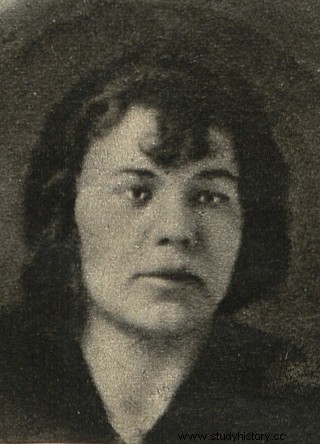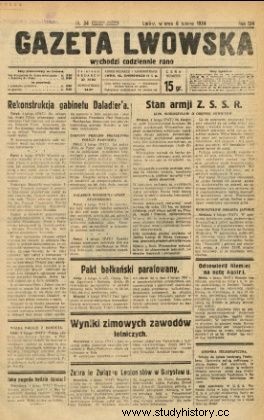On a cold morning on February 5, 1934, Jan Czyż was walking through Park Kiliński as he did every day. He was the caretaker of the Eastern Fair in Lviv and this was where his path to work led. Along the path, he saw something very disturbing:fresh bloodstains leading to the brush.
Across the snow, he walked over to the bushes, and there: There were pieces of meat, probably human, scattered all over the place. The caretaker called the police, although he was under the illusion that it was just some carcass, not traces of a crime. And yet, he did not waste the officers' time. The head of the police station and several constables appeared on the scene.
The head of the investigative department and the detachment of intelligence agents with a police dog also came after them. Already in the preliminary report it was stated: pieces of meat and bones scattered in the brush are parts of the human torso . In the absence of arms, legs and head, however, it was impossible to establish the identity of the victim, much less connect her to the killer.
For many officers it would be a hard nut to crack, but not for Lviv's extortion. In just a day, they tracked down and arrested the perpetrator, proving that they really know their job.
With the help of a police dog (and possibly information from residents), other parts of the body were found in the vicinity of the Nachta brickyard at ul. Tarnowski and in the park on Żelazna Woda. By itself, however, this did not allow the investigation to be advanced. Several clues came to the right track of the policemen.
First, pieces of cardboard boxes made of "Flat" and "Sports" cigarettes were stuck to the body parts found. And there were a lot of these pieces, as if the murder had happened in some store or warehouse.

The idyllic scenery of Kiliński Park concealed a hideous crime ...
Secondly, constable Sobolewski from the first police station saw the kiosk Hieronim Cybulski, a war invalid running a business near Kiliński Park, introduced a woman into his shack, with whom he had locked up there, on Saturday, February 3, around midnight. The police established that: Cybulski lived in the kiosk, and often in the last three years, since he was dead with his wife Józefa, he brought prostitutes to the kiosk.
There would be nothing surprising about it (nor scandalous for policemen who have not seen such things in their lives), if not for the fact that Cybulski had just put up a women's coat for sale and was also keenly interested in the investigation.
The policemen decided to pay him a visit to the kiosk under the park. Inside, they found a real mess. Gazeta Lwowska on February 9 wrote:
The whole floor was littered with blood. In the corners there were bloodied rags and shreds of women's clothing. Several fingers were found among the rubbish on the floor. There was a water box under the counter, and inside the intestines, pieces of meat and bones, and the scalp . On the shelf in the briefcase there was a head massacred so that no facial features could be recognized.
The tools of the murder were on the table:a handball, an ax and a knife that the criminal used to cut the lard when the police arrived.
At the sight of the uninvited guests, Cybulski turned pale and only after a while he stammered out incoherently in the direction of one constable he knew personally: Gentlemen, to me ... I didn't do anything ... she was a prostitute ... However, the newsagent quickly mastered himself and at the police station he began to report quite a coherent, though not entirely meaningful story.

And this is what the criminal and his kiosk looked like. The photo comes from the "Illustrated Daily Kuryer", which informed the whole of Poland about what happened in Lviv.
He maintained that he had met a young girl on Halicka Street last Saturday and had come to know her surprisingly quickly. They wandered around the city for a while, and because they found a common language perfectly well, he finally led the woman to his kiosk, where they started to overthrow a bottle of vodka. Gazeta Lwowska from February 8 reported:
More details are given very vaguely, saying that the girl was trying to kill herself with some kind of poison. After drinking the poison, the girl became seriously ill and lay in the booth on Saturday and Sunday. She died on Sunday. Cybulski testifies further that, fearing responsibility, he proceeded to dismember the girl's body.
Any layman can say that innocent people do not dismember a body. Cybulski himself, after a longer interrogation, also began to get troubled in his testimony. He finally admitted that he had strangled the woman in a drunken frenzy and then dismembered her body. He also gave a second version, according to which he poisoned the deceased with cyanide (this poison was indeed found in the kiosk). He scattered the bits of the body with the help of his friend, an unemployed stonemason, Michał Kołodziej. He assured him that had bought horse meat which he had spoiled .

Emilia Szeffówna, a victim of a bloody crime.
It's horse meat was in fact the body of a 41-year-old prostitute, Emilia Szeffówna. Nobody missed her - not only did she trade with her body, but she also dealt with stolen goods, and in general she belonged to the worst type of street girl.
The clients of the 44-year-old newsagent Cybulski now began telling the police that they had long suspected that something was wrong with him. Apparently betrayed degenerate bloodthirsty instincts . He was skinning dead dogs, and the sight of the blood put him in a strange state. It was said that he not only invited prostitutes to the kiosk, but also organized sexually explicit orgies with their participation. It was whispered that the streetwalkers had disappeared before after visiting the newsagent's. Maybe it was their bodies that he placed in the stove in which Szeffówna's burned shoes were found?
The trial was held on an ad hoc basis - the first hearing is scheduled for February 27. According to the regulations, in such a procedure only one conviction could be passed:death. First, however, it was necessary to determine the sanity of the accused. First, he underwent an xenthological examination , which is typical in such situations to determine if his brain is abnormal.

On February 27, Cybulski was brought to trial. Today such a pace would be completely unthinkable…
Doctors from the General Hospital in Lviv did not find anything like that. Psychiatrists also stated in their report that Cybulski should be considered sane. At the same time, the Lviv legal circles and the press, even before the trial, recognized the newsstand as a type of an extremely cynical murderer. As evidence, the finally reconstructed murder was cited:

He skillfully poured Scheff's poison on the cocksuckers in a glass with vodka which Scheffówna did not notice. (...) He nudged his glass against Scheff's glass containing poison, saying with all cynicism (...):"Cheers".
After slicing the body, Cybulski slept for several hours on the body parts, and woke up and traded all day long.
The trial lasted only two days and on February 28 the court issued a verdict. He took into account extenuating circumstances (partial insanity, although it did not result from psychiatric examinations) and sentenced Cybulski to life imprisonment, instead of the death penalty. If the "butcher from Lviv" did not die behind bars - and the newspapers did not know anything about it - he was released after less than six years, during the September campaign. Who knows how many more prostitutes could have fallen victim to him ...
Source:
Gazeta Lwowska, issues from February 1934.
